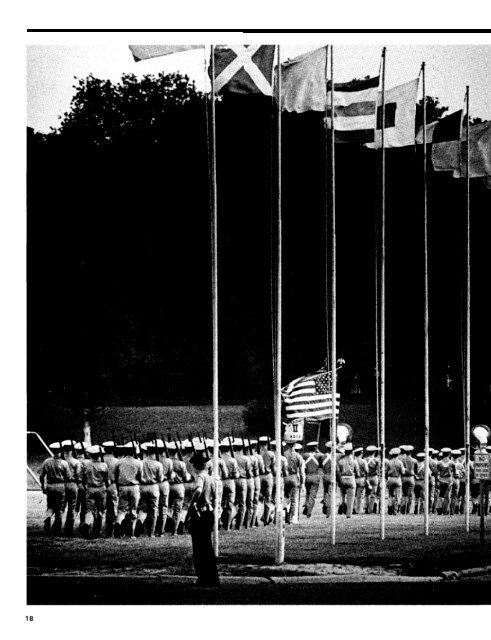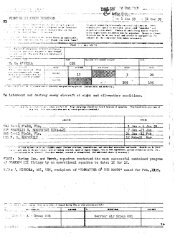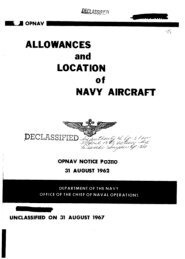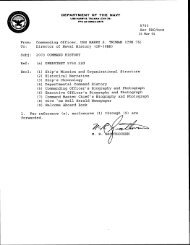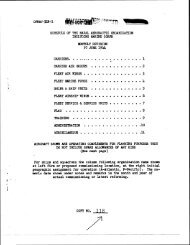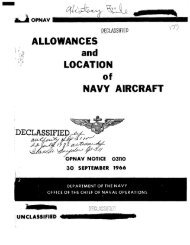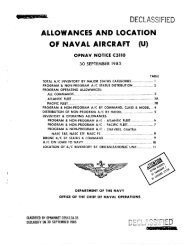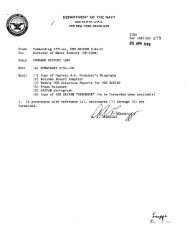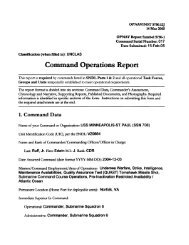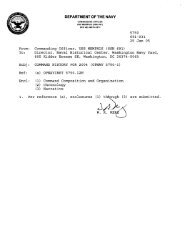Aviation Officer Candidate School
Aviation Officer Candidate School
Aviation Officer Candidate School
You also want an ePaper? Increase the reach of your titles
YUMPU automatically turns print PDFs into web optimized ePapers that Google loves.
Story and Photos by JOCS Kirby Harrison<br />
S ummers are hot in Pensacola, Fla.<br />
When the sun comes up in a haze and<br />
the temperature climbs to 95 in the<br />
shade, the humidity makes an hour in a<br />
sauna seem like a welcome relief.<br />
But not all the sweat at the sprawling<br />
Pensacola naval air station comes from<br />
the sun. Most of it originates in the<br />
pressure cookers called <strong>Aviation</strong> <strong>Officer</strong><br />
<strong>Candidate</strong> <strong>School</strong> (AOCS) and <strong>Aviation</strong><br />
Preflight Indoctrination (API). These 14<br />
and six-weeks-long, respectively,<br />
courses are designed to educate<br />
approximately 1,400 men and women<br />
annually who can and will — and weed<br />
out those who can’t and won’t — meet<br />
Navy standards for becoming Naval<br />
Aviators.<br />
<strong>Aviation</strong> <strong>Officer</strong> <strong>Candidate</strong>s arriving<br />
from civilian life are introduced to<br />
military life and discipline by a Marine<br />
drill instructor. In addition to the<br />
aerodynamics, navigation and power<br />
plants academics they have in common<br />
with the API students, AOCs receive<br />
liberal helpings of seamanship,<br />
organization and administration,<br />
military law, naval leadership and the<br />
principles of sea power. It is a sort of<br />
basic training amplified. Those preflight<br />
students arriving from the U. S. Naval<br />
Academy, Naval Reserve <strong>Officer</strong><br />
Training Corps (NROTC), or other<br />
previous service resulting in<br />
commissioning as an officer, already<br />
have received training in these latter<br />
areas. Both groups go through flight<br />
physiology and water and land survival<br />
training.<br />
“Attention to detail” is a common<br />
phrase among AOCs. Instructors in both<br />
19
AOCS and API feel this attention to<br />
detail and the self-discipline necessary<br />
to achieve it are the most important<br />
factors for becoming Naval Aviators.<br />
They are taught attention to detail<br />
now, so that when the cockpit becomes<br />
their environment they will be aware of<br />
everything around them and not miss a<br />
single thing.<br />
Many students come in with no real<br />
concept of what to expect, and discover<br />
that the most important thing is learning<br />
time and resource management. They<br />
discover it is the only way to get things<br />
done.<br />
Students frequently voice the same<br />
reaction, that there is little demand they<br />
can’t handle. It is the time element<br />
allowed to complete the task<br />
satisfactorily that is the challenge.<br />
The 1983 film An <strong>Officer</strong> and a<br />
Gentleman familiarized viewers with the<br />
physical demands made on the AOCs. It<br />
did not, however, depict the overall<br />
program accurately. Emphasis on<br />
classroom academics and standards of<br />
conduct expected from candidates was<br />
overlooked.<br />
Before pressure chamber training,<br />
classroom preparation for the effects of<br />
rapid altitude ascent and descent on the<br />
human body are necessary. There are<br />
hours of instruction before each phase<br />
of practical application. The Navy’s idea<br />
is not only that the candidate knows<br />
what to do, but why to do it.<br />
Other subjects are taught at length.<br />
Aerodynamics provide a foundation in<br />
basic theory, upon which actual flight<br />
procedures are based. A course in<br />
aircraft power plants includes the<br />
principles and concepts essential to the<br />
operation and maintenance of<br />
everything from reciprocating to jet<br />
engines. Basic navigation provides the<br />
prerequisites for the advanced<br />
navigation course given during the inflight<br />
portion of training.<br />
For some individuals, more selfdiscipline<br />
is needed than for others.<br />
And, for some, just getting into the<br />
aviation officer program is an exercise in<br />
determination.<br />
For Ensign Charlie Gay, getting his<br />
wings came after six years of<br />
perseverance. It began in 1978 when he<br />
joined the old <strong>Aviation</strong> Reserve <strong>Officer</strong><br />
<strong>Candidate</strong> (AVROC) program as a junior<br />
at the University of Colorado. The next<br />
summer he traveled to Pensacola to<br />
complete the first eight weeks of<br />
training. He returned to college, in<br />
20<br />
Alaska, but being a single parent took so<br />
much of his time that it was two years<br />
before he could graduate. In the summer<br />
of 1979, aviation candidate Charlie Gay<br />
was only a few days from receiving his<br />
commission as an officer when the Navy<br />
discovered that no confirmation of his<br />
college degree had been received. In<br />
fact, he was less than two credits away.<br />
“Everyone understood, but it still wasn’t<br />
easy,” he recalled. “I remember the drill<br />
instructor, GySgt. Daggs, telling me<br />
that I’d better get that degree and get my<br />
a— back to Pensacola, because I still<br />
owed him 20 push-ups.”<br />
Gay returned to school in Alaska. In<br />
the fall of 1981, with two degrees in<br />
hand, he was back in Pensacola to<br />
finally complete AVROC training and<br />
receive his commission. “It was one<br />
battle after another,” said Gay, “but I<br />
wasn’t about to quit.”<br />
If all goes well, he will be able to look<br />
back on his naval career and say that he<br />
is a survivor. It runs in the family. His<br />
second cousin is the Ensign George Gay<br />
who was one of only two survivors from<br />
Torpedo Squadron 8 at the Battle of<br />
Midway in 1942.<br />
Not everyone who starts AOCS and<br />
preflight indoctrination will finish.<br />
Twenty-four percent of those arriving at<br />
AOCS will drop in the first week, most of<br />
them a result of not being physically<br />
qualified, or for personal reasons.<br />
Another 11 percent will be lost by<br />
attrition in the remainder of the program.<br />
Approximately six percent of those<br />
arriving, already commissioned, to<br />
begin <strong>Aviation</strong> Preflight Indoctrination<br />
will not finish. A very few will discover<br />
that Naval <strong>Aviation</strong> isn’t for them,<br />
because of academic reasons, and drop<br />
out voluntarily. Others will encounter<br />
physical problems that will prohibit their<br />
flying a naval aircraft. It may be that their<br />
arms are too short to reach certain<br />
controls when strapped into the cockpit,<br />
or there is an inability to clear the sinus<br />
blocks that often come with rapid<br />
altitude ascent or descent. Most likely, it<br />
will be the eyes. The requirement for a<br />
pilot aviation officer candidate is 20/20<br />
vision in both eyes and adequate<br />
peripheral vision.<br />
Some aspiring students arrive only to<br />
discover that their eyes fail to meet the<br />
20/20 requirement. Some switch to the<br />
Naval Flight <strong>Officer</strong> program.<br />
Becoming a naval officer is the bottom<br />
line for these candidates, and flying is<br />
the “icing on the cake.”<br />
For the pilot trainees, the first taste of<br />
flying begins shortly after graduation<br />
from preflight indoctrination. Assigned<br />
to a training squadron at nearby NAS<br />
Whiting Field, Milton, Fla., or at NAS<br />
Corpus Christi, Texas, they learn to fly<br />
the T-34C Turbo-Mentor in primary<br />
flight training.<br />
Primary flight, a 20-week course that<br />
begins with two weeks of ground school<br />
and maintains a continuing academic<br />
requirement throughout, teaches the<br />
basics. It is also a course in the process<br />
of change.<br />
It doesn’t take long for the student<br />
pilots to discover that flying is not simply<br />
a matter of kicking the tires and taking<br />
off. There is the continuing demand for<br />
attention to detail. There are eight<br />
distinct steps in preflighting the<br />
relatively simple T-34C. However, in<br />
those eight steps there are no less than<br />
81 specific points the student must<br />
check from memory, to the instructor’s<br />
satisfaction.<br />
Like preflight indoctrination and<br />
AOCS, there is an attrition rate in the<br />
primary flight phase. It generally runs a<br />
little less than 18 percent.<br />
If the students honestly want to make<br />
it, the Navy will support them.<br />
By the time student pilots complete<br />
their 20 weeks, they have accumulated<br />
approximately 65 hours of actual flight<br />
time, ideally three flights a week. They<br />
have satisfactorily demonstrated a<br />
mastery of takeoffs, close-formation<br />
flying, aerobatics and precision<br />
landings. And they have a thorough<br />
knowledge of instrumentation,<br />
navigation and communications and<br />
have shown an ability to cope with<br />
simulated, and occassionally real,<br />
emergencies.<br />
But completion of primary is not an<br />
end. It is a beginning. The final week is<br />
what some describe as the “real” high<br />
point, even when compared to the first<br />
solo flight. It is at this point they learn<br />
what direction their flying career in the<br />
Navy will take: jet, maritime patrol<br />
(multiengine/prop) or rotary-wing.<br />
Despite rumors over recent years that<br />
increasing numbers of student pilotsare<br />
opting for maritime patrol or<br />
helicopters, jets are still the first choice<br />
by far.<br />
Whether it’s the mystique of the<br />
advertising publicity, studies show that<br />
about 85 percent of the students want to<br />
fly jets.<br />
Three factors govern the pipeline
taken by the students. They are the<br />
needs of the Navy, overall grade average<br />
and student preference, in that order.<br />
With the primary flight training over,<br />
the heat is not off. Whether the student<br />
goes on to jets at NAS Chase Field,<br />
Texas, or NAS Meridian, Miss., maritime<br />
patrol at NAS Corpus Christi, or<br />
helicopters at NAS Whiting Field, the<br />
challenge remains. To be the best. To fly<br />
Navy. •<br />
An <strong>Aviation</strong> Preflight lndocrination<br />
class studies the principles of<br />
aerodynamics.<br />
T-34C Turbo-Mentors line the parking<br />
area at NAS Whiting Field, a scene of<br />
constant activity as student pilots<br />
learn to fly.


